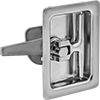Filter by
Material
Finish
Latching Distance
Cam Latch Type
Through-Hole Diameter
Mounting Location
Mounting Screw Size
Latch Turn Direction
Overall Length
Arm Length
Export Control Classification Number (ECCN)
DFARS Specialty Metals
Latching Distance Adjustability
Key Number
Draw Latch Type
Building and Machinery Hardware
Containers, Storage, and Furniture














































